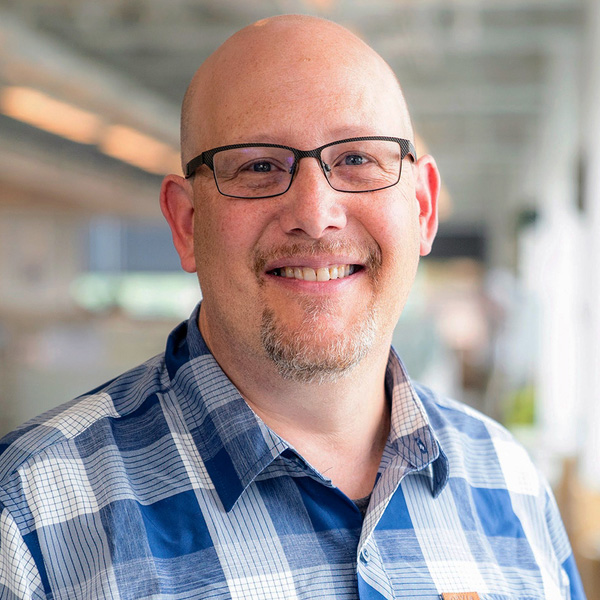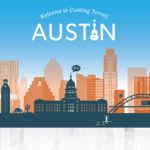Applying workplace design strategies to the classroom (and vice versa)
Over the past decade, we’ve seen a major change in the way workplaces are designed. Not long ago (and still today!), the creative, collaborative, open office environments common now were met with resistance and trepidation. It felt radically different at the time — turning the status quo on its head by creating workplaces that are not only more equitable and democratic, but also facilitate more productive interaction with colleagues, create health and wellness benefits, and fully utilize the latest technologies.
With this shift, we’ve also seen revision and refinement. It’s been a continuous learning process as we look at post occupancy evaluations and feedback from clients in order to best design these environments to suit a variety of company cultures, personality types, and working styles. As we garner more knowledge, we’re finding that the design strategies we use to foster happy, engaged, productive, and successful employees can also be applied to student learning environments.
Corey Johnson, co-lead of our education design studio, recently joined Sandi Rudy, senior interior designer for our commercial design studio, to explore the innovative design decisions made for these projects, and how we can cross-pollinate knowledge and findings between markets.
As designers, it’s important to break out of silos and gain inspiration from as many sources as possible. Many of our designers, architects, and engineers have in-depth experience in multiple markets and we’re known for our collaboration. When we open up the ideation process to a variety of perspectives, we can see projects in a completely new way.
— Corey Johnson, Associate Principal, Education Design Studio Co-Lead
Parallel environments — five examples
1) The first impression
Workplace entries are often designed both to impress and to welcome. They reflect culture and set the tone for employees and customers. They create a sense of pride and tell a story. They must also incorporate critical elements that support ease of reception, and bolster safety and security.

For the Micron headquarters in Boise, Idaho, the technology company needed an entry that wowed, conveyed its roots in technology, and had a highly visible entry and exit for employees and visitors alike. The space is welcoming with a comfortable seating area, oversize screen sharing company images, and enticing views further into the space. Access via a secure badging system occurs right next to the reception area.
To ensure students and staff are embraced in safe, secure spaces, our teams consider and incorporate features such as single-point entry, access control, surveillance, territorial reinforcement, high visibility, and lighting. The key is to bring all these elements together without compromising the intention of the space. One of the primary goals is to maintain a warm, comfortable atmosphere, reinforcing pride of place and a sense of belonging.

The Thorne-Rider Campus Center at Sheridan College in Wyoming is located at the geographic center of campus and serves as a hub for student life. The reception area has full views of the space with campus police located on-site, as well as an always-open dining facility, recreation hall, multi-purpose activity room, commuter lockers, student government, and campus mail.

For Stricker Elementary School in Kimberly, Idaho, the design incorporated the latest school security planning and technology. Walking through the school, the layout offers a logical flow of movement with visual cues. A single-point entry vestibule — with a secondary entry vestibule for buses, locked down after buses depart — funnels school entrants through double-doors located adjacent to administrative offices where staff can keep eyes on all points of the school. The hallway layout was designed so staff can see down one wing directly from the offices, and move only a short distance to see down the other two classroom wings.
2) Creating community
Another key element in the design of both workplaces and schools is a community focal point where people come together for collaboration and celebration. This can be a place where visual storytelling occurs — through branding, employee or student artwork, accolades, and other signage — helping to build culture.
In workplaces, this can happen in a variety of spaces — a central meeting place, kitchens, and even classroom-style areas, borrowing from educational spaces. Some offices have outdoor areas for meeting and gathering that also help connect employees to nature and/or urban neighbors and other businesses.

This cozy auditorium space designed for a large technology client provides an opportunity for knowledge sharing both within the company and the community. A variety of seating options throughout allows the space to be used in a variety of ways, from formal lectures to casual collaboration.
Schools can bring together internal and external communities through places for gathering, socializing, eating, celebrating, presenting, and displaying. Social interactions with neighborhood, educational, and business partners can be supported and enhanced in places such as a commons area, multi-purpose rooms, gymnasiums, and/or performance spaces. A vibrant and healthy school is one that is open and accessible to the community.

Currently under construction, the new Gallatin High School in Bozeman, Montana, was designed around a “town center” concept — a place where students and staff come together for a variety of purposes. As a dynamic shared space at the heart of the school, it creates a unifying element both architecturally and socially. It’s a place where the school’s smaller neighborhoods and academic communities can come together, share, and connect.
3) Responding to diverse needs
Flexible, multipurpose environments require a high level of coordination to configure the spaces, optimize adjacent areas for employee and student growth, and encourage exploration and new experiences. In most cases, one size does not fit all, thus the drive to mix things up.
While logistically and economically, there must be some uniformity in the spaces we design for large groups, we can also add variation and character, it just takes a little out-of-the-box thinking when it comes to space utilization. Space can be allocated in a non-permanent way by utilizing furniture dividers with multiple functions, such as marker boards and acoustic or tackable panels. Multi-functionality can also be added into the space itself by planning flexible seating, tables, and even walls.

As part of the award-winning, mixed-use Tenth and Main project in Boise, Idaho, the workplace we designed for Kount Inc. includes breakout spaces and collaboration areas tucked in among more traditional desk/computer work areas.
The most functional learning environments are highly adaptable with durable, mobile furniture, and transforming doors and walls. Our teams focus on utilizing every square foot for learning, such as converting the 20% of space lost to circulation into dynamic breakout spaces. This type of programming can assist with budget and schedule considerations as well as enhance sustainability by giving spaces a dual purpose. For example, incorporating technology such as multi-projection systems and high-quality acoustic partitions allow rooms to be quickly converted from learning to lecture spaces.
A wide variety of learning areas, both inside and outside the classroom, can support how students process information while fostering the cognitive and social skills necessary for growth and success. Environments that support quiet time, teamwork, and hands-on activities, as well as foster relationships with teachers, community partners, and mentors are all important. Our planning strategies aim to utilize every square foot for learning and relationship building.

The spaces within St. Ignatius Catholic School in Meridian, Idaho, are easily subdivided into small learning communities where students can work independently or in groups.
4) Health and wellness, built in
As children, we spend a lot of time at school, and as adults, we spend an even greater amount of time in the workplace. It makes sense that these environments support healthy lifestyles and well-being, as well as provide good indoor air quality, thermal comfort, proper acoustics, and exposure to natural daylight. Design should be site and climate-responsive, place a priority on sustainable building systems, and factor in the reduction of life-cycle costs, as well as energy and resource conservation.
Both offices and schools have become more holistic with gyms and enhanced play areas, kitchens and café’s with healthy food choices, organized group wellness activities, and the incorporation of biophilic features, which connect people to greenery and nature, even indoors.


Whether incorporating views of greenery and the outdoors through the building shell or creatively adding in greenery to interior spaces through biophilic elements, the spaces we create can be expansive or intimate, but still create a connection to nature.
A connection between indoor and outdoor spaces is a critical component of creative learning. Outdoor learning and exploration can take many forms: windows and convertible openings in buildings with views to the outside, studying nature through interactive walks, messy science experiments, gardening, witnessing sustainable strategies in use, and having the freedom to just be kids. When outdoor spaces are easily accessible, teachers can also take advantage of good weather to create break-out areas.
Numerous studies show a strong correlation between good indoor air quality, thermal comfort, acoustics, and daylight with 20% higher student performance and 15% lower absenteeism. A healthy school is also one that’s safe and secure, with the ability to easily observe the education environment to minimize bullying and mischief, and quickly respond to a threat.

St. Ignatius Catholic School is site- and climate-responsive, placing a high priority on natural daylight, energy-efficiency, the creation of healthy spaces for learning and teaching, and the reduction of life-cycle costs.
5) Future adaptability
As designers, it’s hard to predict change, but creating spaces that can adapt to change is vital to a building’s long-term success. Productive, efficient, impactful, collaborative workplaces and learning environments are dependent upon technology that not only supports day-to-day activities but is seamlessly integrated and interwoven throughout the spaces. For this task, our architects and engineers collaborate with clients on the intricate details that consist of everything from device plug-in needs and audio-visual presentations, to the integration of learning through virtual reality and visualization tools.
Technology supports mobility and mobility supports creativity, not to mention the philosophy that work and learning can happen everywhere. With more choice in where people work and learn, you can also accommodate for differing needs and comfort ranges.

For the Dell Experience Lounge at Round Rock, we renovated approximately 3,000 sq. ft. of existing office area into a unique, high-concept space with cutting-edge audiovisual features where team members can learn about the latest Dell products.
Today’s education curricula requires students have access to tools and information at any time. Accessibility to wireless, desktop units, smart screens and boards, multiple screen capture for group collaboration, distance and on-line learning allow students to grow and create in a technology intensive world.
Technology infrastructure must be designed in a way that is adaptable for a wide array of users: students (of varying ages), educators, administrators, and sometimes the community as a whole. Both flexibility and durability of technology integration are always guiding principles in the planning process and are incorporated into design and construction decisions.

Within the Thorne-Rider Campus Center, technology is infused throughout the building, promoting constant connection and collaboration. The connection to technologies must be easily accessible whether in individual, small or large group interactions.

Montana Tech’s Natural Resources Research Center has labs where students and staff need flexible access to power, technology, and ventilation for ongoing prototype building, and research and development.
Continuous learning — why stop?
One of the basic principles that has come out of this cross-pollination is the importance of continuous learning, at all ages. Schools lay the framework to inspire and evolve the lifelong learner, and provide the tools and resources to help each child transition from student to worker. In today’s world, a designer’s responsibility is not only to provide an environment where students can learn, but also where they have the freedom to grow and make social connections. After all, the students of today are the teachers, doctors, architects, engineers, scientists, politicians, and executives of tomorrow.
Looking at what makes successful learners in a school environment can help us determine what will make successful employees in an office environment. They’re parallel concepts. We never want to stop learning, and the spaces we create, even beyond the classroom, should foster this ability.
– Sandi Rudy, Associate, Senior Interior Designer

In schools, we’re preparing the next-generation workforce. As such, our designs should harness what’s best about each experience and environment, while ensuring flexibility so spaces can respond to changing needs and changing times.
– Corey Johnson, Associate Principal, Education Design Studio Co-Lead
















